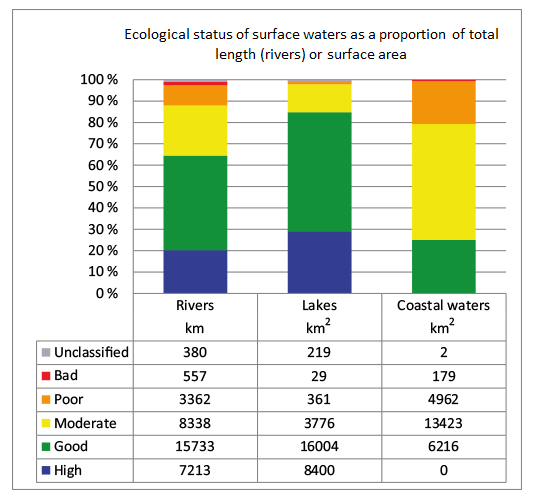Press release 2013-10-02 at 15:46
 Ministry of the Environment, Finnish Environment Institute and Finnish Game and Fisheries Research Institute
Ministry of the Environment, Finnish Environment Institute and Finnish Game and Fisheries Research Institute
A new assessment of the ecological status of Finland’s waters shows that 85% of the surface area of our lakes and 65% of our rivers are in a good or very good state. However, three-quarters of the surface area of our coastal waters are in a worse state. The main problem is eutrophication.The ecological status1) of large lakes and northern Finnish waters, in particular, is largely good or very good. In contrast, small lakes suffer from eutrophication.
Along the coast, none of the water areas were classified as high. The status of the Finnish Archipelago Sea and the Gulf of Finland is especially worrying. However, the quality of the easternmost reaches of the Gulf of Finland has improved as a result of water protection measures and particularly thanks to improved waste water treatment in St Petersburg. The status of coastal waters in the northern parts of the Bothnian Bay and estuaries in the Gulf of Bothnia has declined in places.
”Finland’s water protection measures have been ambitious, but inadequate when it comes to preserving aquatic ecosystems. Even after pollutant and nutrient loads are reduced, it can take a long time for water quality to improve,” says Environment Minister Ville Niinistö.
The data for assessing the ecological status of waters was compiled in 13 centres for economic development, transport and the environment. The status of fish was assessed by the Finnish Game and Fisheries Research Institute. The assessment is based on data gathered between 2006 and 2012. The previous assessment was from 2008.
Information on the status of waters will help in protection measures
The European Union aims to achieve a good ecological status for surface waters2) in the entire EU area by 2015. However, reaching this goal will require more time. The published assessment on ecological status provides more detailed information on waters where water protection measures are needed. The assessment will also be used in water resources management plans, which are drawn up every six years. The government will make its decisions on the next water resources management plans in 2015.
“Water protection measures are primarily the responsibility of those whose operations negatively impact the ecological status of waters," says Niinistö.
In Finland, over half of the nutrient load that causes eutrophication in water bodies comes from agriculture. Communities are still significant sources of nitrogen discharges, while sparsely populated areas result in a significant portion of Finland’s phosphorous discharges.
The ministerial meeting of the Baltic Marine Environment Protection Commission, which is to be held tomorrow, 3 October, will approve the country-specific targets for the Baltic countries for reducing nutrientnutritional loads. According to Niinistö, reaching these targets will require reforms, especially regarding agri-environmental support.
“Agri-environmental support should be reformed to better support the protection of aquatic and natural biodiversity. Agri-environmental support measures should be targeted regionally, according to ecological status and sector-specifically to areas where water protection is needed the most," says Niinistö.
The status of river waters is further worsened by hydraulic engineering. Almost all the large rivers in Finland that empty into the Baltic have been modified, resulting in the extinction of native migratory fish stocks.
“Migratory fish stocks could be reintroduced to several rivers by building fishways and restoring rapids. Last year, the Government approved a resolution as a new national fish strategy. The goal for the next phase of the strategy is to restore fish pathways past 55 dams in 20 different waterways," says Niinistö.
A similar status assessment will be carried out in all EU countries. In Finland, the work has been challenging due to the large number of water bodies, and it has not been possible to classify all of them. Coastal waters have been assessed in their entirety, while 87% of the surface area of lakes has been classified. The classification criteria have also been clarified from last year.
An assessment of the chemical status of waters will be published in late 2013. A status assessment of groundwater was published in the summer.
Citizens can take a closer look at the status of Finnish waters using the Finnish Environment Institute’s new map service.
More detailed information on the regional status of water bodies is also available at centres for economic development, transport and the environment.
More information:
Saara Bäck, Senior Environmental Adviser, Ministry of the Environment, tel. +358 (0)400 285 410, firstname.lastname@ymparisto.fi
Hannele Nyroos, Senior Environmental Adviser, Ministry of the Environment, tel. +358 (0)50 572 6358, firstname.lastname@ymparisto.fi
Classification of water quality:
Sari Mitikka, Limnologist (lakes, rivers), Finnish Environment Institute, tel. +358 400 148 827, firstname.lastname@ymparisto.fi and
Pirkko Kauppila, Special Researcher (coastal waters), Finnish Environment Institute, tel. +358 (0) 400 148 530, firstname.lastname@ymparisto.fi
Fish:
Jukka Ruuhijärvi, Researcher, Finnish Game and Fisheries Research Institute, tel. +358 (0) 400 219613, firstname.lastname@rktl.fi
- - -
1) The assessment of ecological status primarily looks at biological quality. The conditions in water bodies concerning plankton algae, diatoms, aquatic plants, benthic fauna and fish is compared to conditions where human activity has not caused discernible effects in flora and fauna. The lower the human effects, the better the ecological status of a water body. The assessment also considers the chemical quality (total nutrient load, pH, visibility) and hydromorphological factors (such as obstacles to migration, regulation) of the water body.
2) Surface waters: a separate and significant part of surface waters, such as a lake, reservoir, stream, river or channel, a part of a stream, river or channel or part of a coastal waterway.